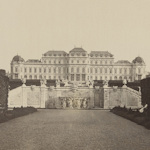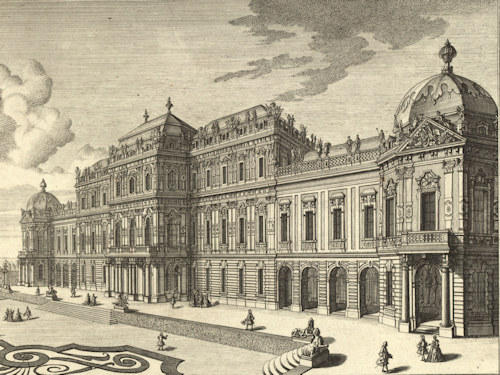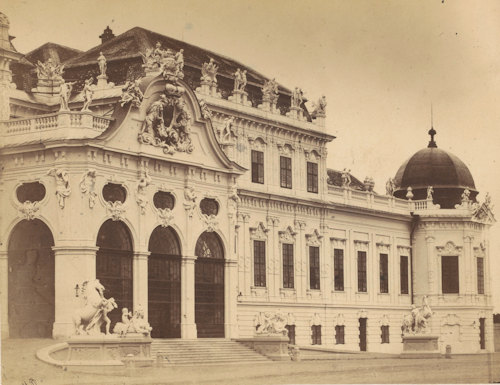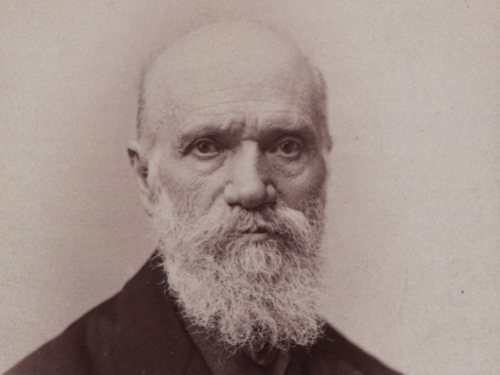
Most people visit Belvedere for the art and architecture. But if you’re wondering how both came to be…
- Palaces date back to the early 1700s
- Built by Prince Eugene of Savoy
- Wall chart presents the chronology of the buildings & institution
- Chart is in English and German
- Book Upper Belvedere tickets* online
- See also:
Belvedere’s origins

(Copper engraving of Upper Belvedere in a 1737 publication; drawn by Salomon Kleiner, engraved by Johann August Corvinus and published by Johann Andreas d. Ä. Pfeffel; Wien Museum Inv.-Nr. 105765/129, excerpt reproduced with permission under the terms of the CC0 licence)
Built between 1717 and 1723, Upper Belvedere palace started life as the purely ceremonial residence of the military genius, Prince Eugene of Savoy.
Eugene’s actual residence lay at the other end of the main Belvedere gardens: the U-shaped Lower Belvedere palace was built in 1716 under the watchful eye of architect and military engineer, Johann Lukas Hildebrandt.
A lot of us have crockery for daily use and the crockery we bring out for visitors. Eugene seemingly applied the same principle to palaces.
(It still shocks me to realise that the upper palace was largely representational. Imagine building a second, more ostentatious house on your property just so you can better impress visitors and have more room for the vol-au-vents.)
With Upper Belvedere largely for show, then, Lower Belvedere served more pragmatic functions.
Though if that sounds like the lower palace was all bare walls and dustbins, you couldn’t be farther from the truth. A prince likes to live in decorative splendour.

(Late 19th-century photo of Belvedere. Courtesy of the Rijksmuseum)
Eugene fought a lot of battles, won most of them, and made sure we never forget the fact by decorating both of his homes with constant reminders of his achievements.
Put it this way: nobody called him Eugene the Modest.
Various locations within Upper Belvedere, for example, feature pictures of these battles, along with triumphalist wall decorations and ceiling paintings of the prince being honored by grateful figures from mythology.
While many parts of both palaces now consist of modern-style gallery rooms to host the priceless art on display, other parts retain much of their historical grandeur.
You can imagine Eugene discussing each room with his prospective interior decorator in the early 1700s:
“Your suggestion for the north wall?”
“Perhaps a battle scene, my prince. It keeps the servants on their toes.”
“Can we put one on the ceiling, too? My image should be surrounded by angels. And Gods. And laurel wreaths. Especially laurel wreaths.”
“Um…”
“You think it too much?” [Eugene moves hand to sword hilt]
“Not at all, my prince. Perhaps we might add some enemy soldiers in chains, too?”
“You’re hired.”

(Eduard Ritter von Engerth (1818 – 1897), painter, museal civil servant, director of the k.k. Gemäldegalerie in Belvedere, around 1897, photographed by Josef Löwy; Wien Museum Inv.-Nr. 133392, excerpt reproduced with permission under the terms of the CC0 licence)
Like many 18th-century buildings in Vienna, Belvedere went on to have an eventful history.
The history exhibition
A small ground-floor exhibition at Upper Belvedere traces that chronology, which took the location from a sparkle in Prince Eugene’s eyes to today’s world-class art collection and museum.
At the time of writing, this exhibition is limited to a long wall chart. You find it just beyond the museum shop, immediately to your left once through the ticket check.
Next on your trip around Upper Belvedere: the The Middle Ages to Renaissance Collection